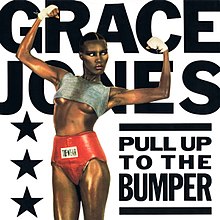| "Pull Up to the Bumper" | ||||
|---|---|---|---|---|
 | ||||
| Single by Grace Jones | ||||
| from the album Nightclubbing | ||||
| B-side |
| |||
| Released | June 1981 | |||
| Studio | Compass Point Studios, Nassau, The Bahamas | |||
| Genre | ||||
| Length |
| |||
| Label | Island | |||
| Composer(s) |
| |||
| Lyricist(s) | Grace Jones | |||
| Producer(s) | ||||
| Grace Jones singles chronology | ||||
| ||||
| 1985 re-release cover | ||||
 | ||||
| Music video | ||||
| "Pull Up to the Bumper" on YouTube | ||||
"Pull Up to the Bumper" is a 1981 song by Jamaican singer, songwriter, model and actress Grace Jones, released by Island Records as the third single from her fifth album, Nightclubbing (1981). Sonically, it is an uptempo[1] electro-disco,[2] post-punk,[3] dance-pop[1] and reggae-disco[4] song with dub production,[5] "pulsing drums and chic new-wave licks",[6] as well as elements of funk and R&B music.[1] Its lyrics were written by Jones alone,[7] while she, along with Kookoo Baya and Dana Manno, are credited as its composers. The song's instrumental part was originally recorded in 1980 during the Warm Leatherette sessions; however, it did not make the album as Chris Blackwell found its sound not fitting in the rest of the material.[8] It was completed for the 1981 critically acclaimed Nightclubbing album and became its third single in June 1981. The song peaked at number two on the US Billboard Hot Dance Club Songs chart and number 53 on the UK Singles Chart. When re-released in 1986, it peaked at number 12 in the UK. The track has come to be one of Jones' signature tunes and her first transatlantic hit.
The song sparked controversy for its sexually suggestive lyrics, prompting some radio stations to refuse to broadcast it.[9] Among the lines are "Pull up to my bumper baby / In your long black limousine / Pull up to my bumper baby / Drive it in between", "Grease it / Spray it / Let me lubricate it" and "I've got to blow your horn." However, in a 2008 interview with Q magazine, Jones suggested that the lyrics were not necessarily meant to be interpreted as a metaphor for anal sex.[10]
- ^ a b c "Grace Jones - Pull Up to the Bumper | Original Vintage Poster". Chrisholm Larsson Gallery. Archived from the original on 12 December 2020. Retrieved 12 December 2020.
- ^ MTV News Staff (25 March 1998). "Grace Jones Retrospective". MTV News. Archived from the original on 12 December 2020. Retrieved 12 December 2020.
- ^ Jones, Daisy (2 August 2018). "The Guide to Getting into Grace Jones". VICE. Archived from the original on 12 December 2020. Retrieved 12 December 2020.
- ^ Skolnik, Jes (18 June 2018). "50 Songs That Define the Last 50 Years of LGBTQ+ Pride". Pitchfork. Archived from the original on 12 December 2020. Retrieved 12 December 2020.
- ^ Vine, Richard (15 June 2011). "Grace Jones pulls up to the bumper". The Guardian. Archived from the original on 5 January 2021. Retrieved 5 January 2021.
- ^ Walters, Barry (25 August 2015). "As Much As I Can, As Black As I Am: The Queer History of Grace Jones". Pitchfork. Archived from the original on 12 December 2020. Retrieved 12 December 2020.
- ^ Levine, Nick (22 June 2020). "Why Grace Jones was the most pioneering queen of pop". BBC. Archived from the original on 12 December 2020. Retrieved 12 December 2020.
- ^ "Pull Up to the Bumper by Grace Jones Songfacts". www.songfacts.com. Retrieved 2 February 2012.
- ^ Jones, Daisy (9 January 2017). "Grace Jones and the Power of Sex". Vice. Retrieved 27 April 2021.
- ^ "Grace Jones laughs off 'Bumper' sex myth". Q Magazine. 18 December 2008. Archived from the original on 18 August 2011. Retrieved 1 February 2012.